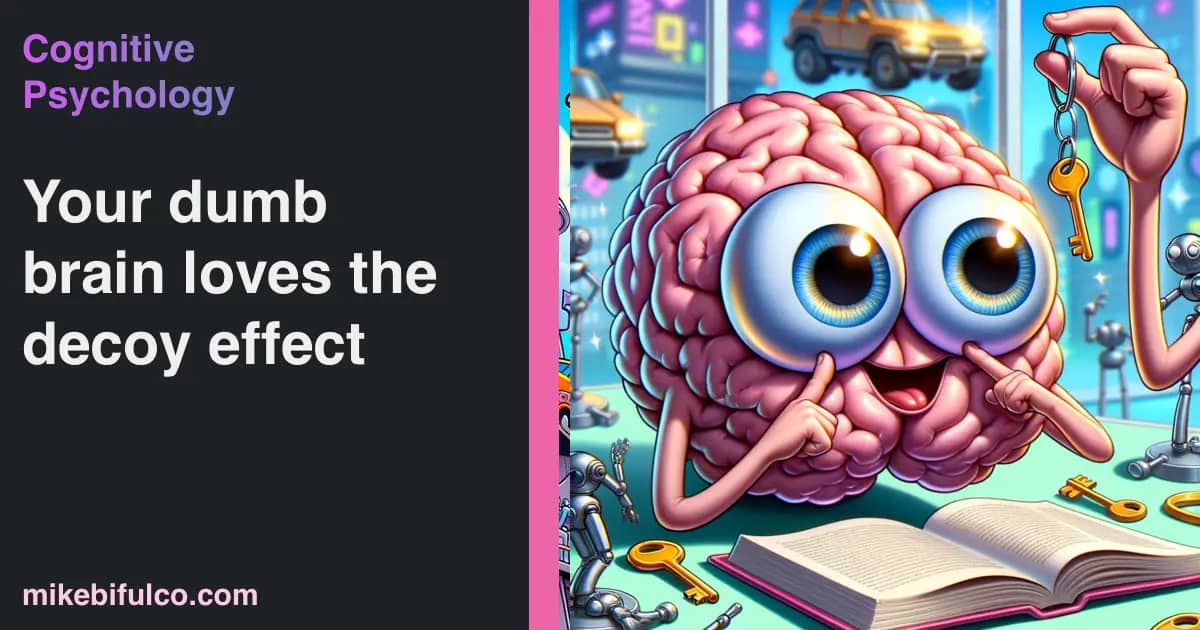- Home
- Newsletter
- The Decoy Effect: More options for an easier choice
The Decoy Effect: More options for an easier choice

Last week, Apple had a press event where they announced updates to their Macbook Pro laptops. They're better, faster, and more power efficient than ever - no surprises there. Since apple started delivering devices that use their proprietary processors, they have been leading the pack in terms of performance and efficiency.
Their computers are exceptional devices, and great for people who want to get work done. But they are also expensive. The new Macbook Pro starts at $1,599, and can go up to a startling $6,899. That's a lot of money for a laptop.
Generally speaking, if you're looking at a Macbook, you're not also looking at a Dell or a Lenovo. This puts apple in an interesting position: when someone is looking to buy a Macbook, they are not comparing it to other companies' products. They are comparing it to other Macbooks.
So, if you've convinced yourself that it's time to buy a new Macbook Pro, you'll find yourself looking at this page:

You're given 3 options: the entry level MBP for $1599, a mid-tier build for $1799, and a high-end build for $1999.
Which one would you choose?
Three options, but only two choices
If you're shopping on a tight budget, the entry level model might be a no brainer. But if you've got some room to breathe, you might be tempted to go for the mid-tier configuration. It's only $200 more, and you get twice as much storage.
But then... what about the high-end model? For a mere $200 more, you get a more CPU and GPU cores, more than twice as much memory (8GB->18GB), and faster USB ports. Storage does go back down to 512GB, buuuut you can upgrade that, too, if you really want to.
It's a slippery slope. I'm willing to bet Apple sells far more of the top-tier configuration than the mid-tier one.
This is the Decoy Effect.
The Decoy Effect is a cognitive bias that causes people to have a strong preference between two options, when presented with a third option that is inferior to one of the original options.
Wikipedia explains it like this:
The decoy effect is the phenomenon whereby consumers will tend to have a specific change in preference between two options when also presented with a third option that is asymmetrically dominated. An option is asymmetrically dominated when it is inferior in all respects to one option; but, in comparison to the other option, it is inferior in some respects and superior in others.
In practice, this means that when presented with two options, buyers have a hard time choosing between them. But if presented with a carefully crafted third option, the decision becomes much easier.
For real: giving your customers more choice makes it easier for them to make a decision.
The Economist's pricing experiment
Perhaps the most famous example of this is from The Economist. In 2009, they ran an experiment where they offered two subscription options:

In this case:
- 68% of people chose the web-only option
- and 32% chose the more expensive web + print option.
Then, they ran a second experiment, where they added a third option:

With a third option added:
- 16% of people chose the web-only option
- 0% chose the print-only option
- 84% chose the web + print option.
In other words, offering a third (clearly inferior) option increased sales of the top tier dramatically.
The lesson: product tiers are powerful
This is why almost every SaaS company has multiple product tiers. It's not just to make more money (although that's a nice side effect). Not only do product tiers make it easier to drive more revenue, they also make it easier for your customers to make a decision.
That's wildly powerful stuff.
So, for all my friends out there building products to sell to other people: don't undermine yourself by offering a single product tier. Give your customers options, and make it easy for them to choose.
More on the Decoy Effect and Behavioral Economics
- The Decision Lab has a great article called The Decoy Effect, explained which dives further into the psychology that drives consumers to make decisions this way.
- When you're ready to put together a pricing table to present to your customers, Stripe's Pricing Tables feature makes it effortless to create a beautiful, effective pricing table. In fact, I used them to mock up screenshots for the economist example above!
- If you're looking for a primer on Behavioral Economics, you can't beat Predictably Irrational, by Dan Ariely.
💌 From the Tiny Improvements Mailbag
Last week, I asked you to send me the projects that you're working on. Here are a couple of the responses I got:
- Aaron Dodge is working on a relaunch of his website. If you're looking for expertise in building a presence on social media, Aaron is your guy.
- My friends at Swishjam have pivoted their business to focus on building a "better way to unify your customers' data and get meaningful insights". It looks promising, and is Open Source, too!
Even more of you replied to let me know that you're working on something, but you're not quite ready to share it yet. I can't say it enough: share your work early and often. It's the best way to get feedback, to build and audience, and to validate what you're doing.
I'd love to keep featuring your projects in this newsletter. If you're working on something, [hit reply](mailto:hello@mikebifulco.com] and let me know about it!
As for me, I just got back from an incredible 2-week vacation to Vietnam and Japan. I have never taken 2 weeks off of work before, and I can't tell you how grateful I am to my team at Craftwork for making it possible. I am beyond lucky to work with such an incredible group of people.
I took a ton of pictures during my trip with my trusty Fujifilm x100v. I've been sharing some of them over on Threads (@irreverentmike):
If you're on threads, hit me up and say hi!
Until next time...




